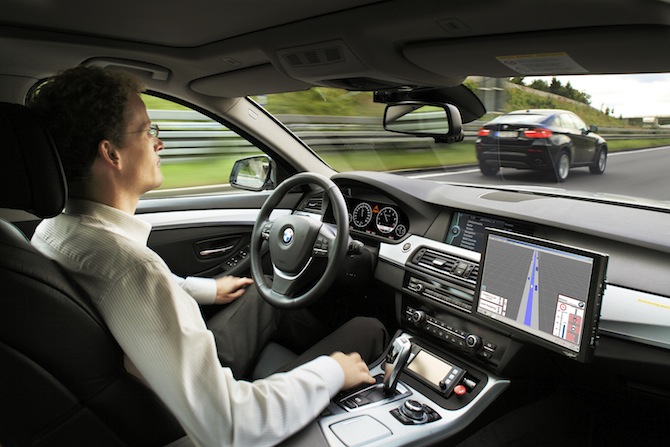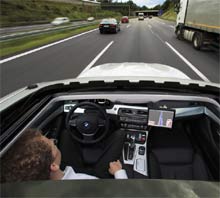
Cars that park themselves and automatically convoy with other cars could reduce congestion and emissions.
Several automakers are developing technology to let cars drive themselves, mainly as a way to make driving more convenient and improve safety. But it could also significantly reduce gasoline consumption, says Nady Boules, the director of GM’s Electrical and Controls Integration Lab.
Increased automation could reduce congestion, but also allow for radical redesigns of automobiles to make them lighter and more fuel-efficient. Boules says partially automated vehicles that let drivers take their hands off the steering wheel and the accelerator, but still require them to pay attention, could be sold by the end of the decade.
 Some cars already have a system that prompts drivers to change the way they accelerate to drive more efficiently. Allowing the car to control acceleration automatically could also save fuel.
Some cars already have a system that prompts drivers to change the way they accelerate to drive more efficiently. Allowing the car to control acceleration automatically could also save fuel.
But the biggest effects could come with full automation. Cars that park themselves—a trick GM has demonstrated with its EN-V concept vehicle—could save fuel by eliminating the need for drivers to circle the block waiting for a parking space to open up. The ambition is for a car to drop its owner off and go directly to the nearest available parking spot—even if that spot happens to be miles away, too far for the owner to walk. When it’s time to leave, the owner notifies the car with a smart phone, and it picks him or her up.
Vehicle-to-vehicle communication, which allows vehicles to travel on highways very close together at consistent speeds, could also reduce fuel consumption. If a truck in a convoy brakes, it sends a signal slowing down the following trucks instantaneously. A spacing of four meters reduces wind resistance for the following trucks, and could reduce fuel consumption by 10 to 15 percent, Boules says. Vehicle-to-vehicle communication could also reduce congestion by cutting accidents, coordinating traffic intelligently, and “getting rid of those drivers who accelerate through red lights.” The U.S. Department of Transportation is sponsoring work to enable this last goal using sensors in stop lights that can communicate with smart vehicles.
In the more distant future, if automated cars prove as safe as Boules thinks they can be, it could allow engineers to completely redesign cars. “You could remove the weight dedicated to crash protection, using very light materials for the skin instead of metals,” Boules says.
Boules believes fully automated cars could be built by the next decade, but admits that new regulations will be needed before they can be sold.
Automakers have been working on vehicle automation for decades, but the work recently got a boost from a DARPA-sponsored contest to develop vehicles that can navigate a simulated urban environment on their own. A team that included GM and Carnegie Mellon University won that contest. Google is also pushing vehicle automation, and has tested autonomous vehicles for over a hundred thousand miles; the company is also reportedly sponsoring a bill that clears the way for automated vehicles to drive on public roads in Nevada.
Source: technologyreview

 Follow
Follow